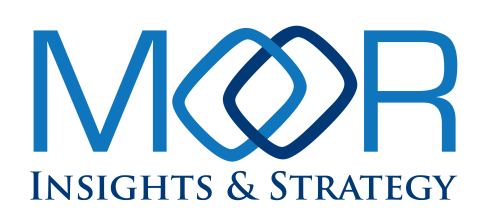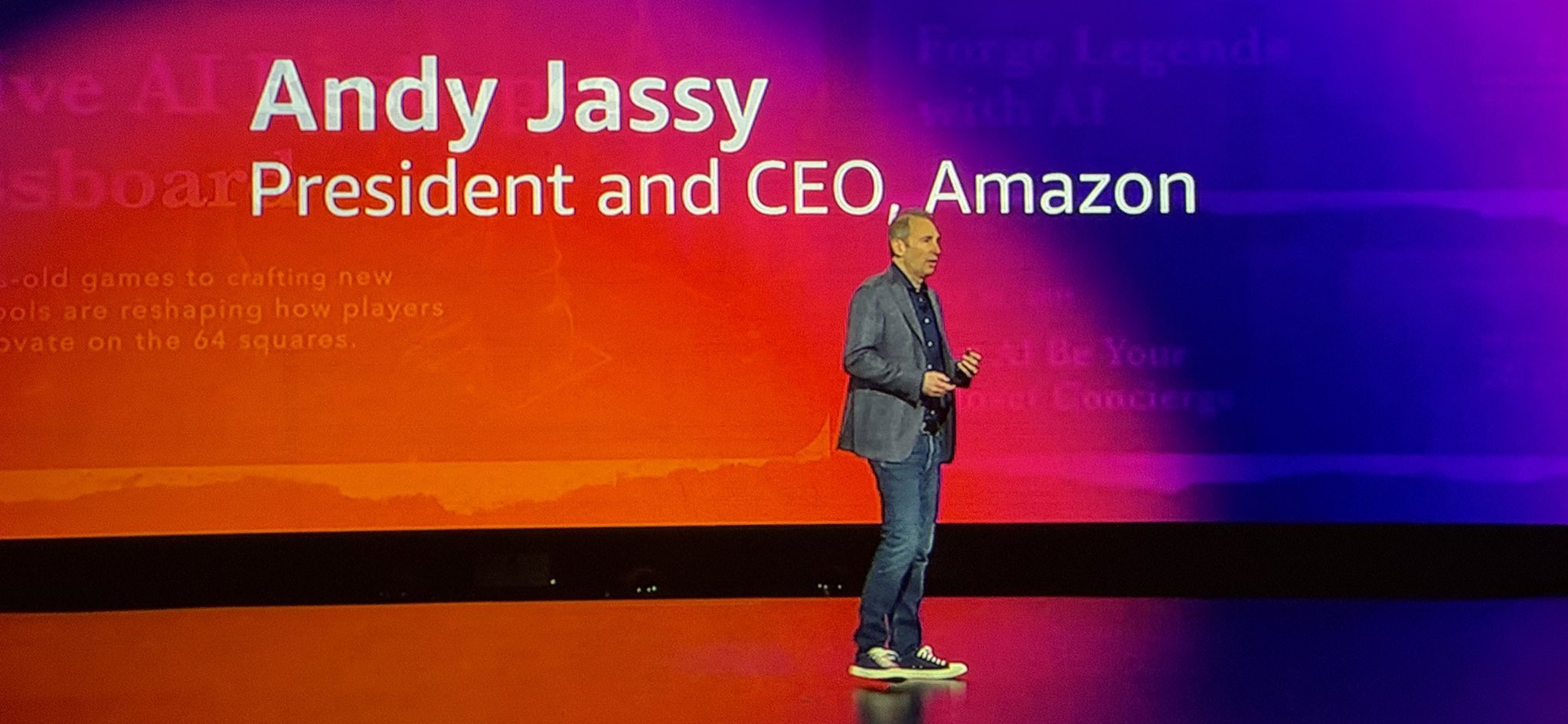
Welcome to this edition of our Weekly Analyst Insights roundup, which features the key insights our analysts have developed based on the past week’s events.
The time between Thanksgiving and Christmas is hectic but rewarding for me, with lots of events and client meetings between the rounds of holiday cheer with the family. Last week, I was fortunate to be with a few members of my team in Las Vegas for AWS re:Invent. Matt, Jason, Robert, and I were all there covering our various specialty subjects—and figuring out how it all fits together for a company with the reach of AWS. It’s always great to see the analysts in action, and Jason recorded his first Six Five video. You can check that out, along with all the other re:Invent Six Five coverage, here.

While we were in Vegas, Will was in Dallas for AT&T’s Analyst & Investor Day, and Anshel traveled to a couple of NDA meetings with clients that will feed some of his future articles. This week, I’m in Northern California for the Lattice Developer Conference and then Marvell’s Industry Analyst Day, where Matt will join me. Robert and Jason will be in Boston with IBM, and Anshel will be attending T-Mobile’s Analyst Summit. Mel, Jason, and Robert will all be tuning into the ServiceNow Global Industry Analyst Digital Summit.
It’s a lot of travel, but also a lot of learning and many chances to connect with and advise our clients. We wouldn’t have it any other way. We’ll be starting 2025 with a bang, too, as many of us attend CES. If you are going to be there and we don’t already have something scheduled, please reach out and let’s set something up.
Have a great week,
Patrick Moorhead
———
Our MI&S team published 20 deliverables:
Over the last two weeks, MI&S analysts have been quoted in multiple syndicated top-tier international publications such as Barron’s, ComputerWorld, Fierce Network, Investor’s Business Daily, The Register, and VentureBeat. The media wanted MI&S’s take on Avaya, AWS, Intel and more. Pat made several network television appearances, including CNBC to discuss Intel’s CEO departure.
MI&S Quick Insights
Last week was all about the Amazon Web Services re:Invent conference, for which 60,000 people descended on Las Vegas. It was quite an event, and AWS came out swinging with announcements up and down its stack. Here were the biggest news items on the developer side:
My personal favorite announcement of re:Invent was the new transformation capabilities in Q Developer. For context, Chapter 1 (out of 4) in my career was in systems integration and consulting; the big takeaway from that chapter was that migrations are hard—and maybe I should consider moving on to Chapter 2. One key lesson learned was that anything that can alleviate the pain of migrations and upgrades will make enterprises more secure and more efficient, and give them more time and money to innovate. AWS’s solid use case shows the enterprise potential of agentic apps and gen AI. Check out the piece that I published in Forbes about AWS agents.
For a Six Five on the Road videocast, I got to interview Sherry Marcus, Ph.D. about gen AI and AWS Bedrock. I have met Sherry before and was so happy that this time we got it on video. Bedrock has significantly expanded its capabilities in the newest release to support agentic applications. Bedrock is looking a lot like a great enterprise solution, but it is not alone, given the release of Microsoft’s AI Foundry at the Ignite conference a couple weeks ago. What we are starting to see is the formation of a new type of middleware category that I am calling agentic development frameworks. This is the type of technology that will get us past productivity agents operating within application platforms (which still do have their place) and get us into integrated high-scale agentic solutions. Want to know more? Check out the Forbes piece I wrote about these agentic frameworks.
While AWS generated a lot of focus, re:Invent is also something of an ecosystem show for the cloud. So, partners and partner announcements were everywhere as well. I got to speak to product leaders from IBM, which made multiple announcements of their own products running upon and in some cases integrating with AWS cloud. It’s an interesting combination, as IBM is a major champion for hybrid cloud, and its tools could help create a bridge for management, governance, and observability anywhere that applications are deployed.
There was also a lot of talk about AWS SageMaker’s new unified toolset. At first glance, it may seem like it’s simply a means to unify the data-scientist experience, but after doing some digging I was able to find out that what was announced this week was only step one. I think we will be seeing a great deal of work integrating SageMaker with Amazon Bedrock in 2025.
Last week was all about the Amazon Web Services re:Invent conference, for which 60,000 people descended on Las Vegas. It was quite an event, and AWS came out swinging with announcements up and down its stack. Here were the biggest news items on the developer side:
My personal favorite announcement of re:Invent was the new transformation capabilities in Q Developer. For context, Chapter 1 (out of 4) in my career was in systems integration and consulting; the big takeaway from that chapter was that migrations are hard—and maybe I should consider moving on to Chapter 2. One key lesson learned was that anything that can alleviate the pain of migrations and upgrades will make enterprises more secure and more efficient, and give them more time and money to innovate. AWS’s solid use case shows the enterprise potential of agentic apps and gen AI. Check out the piece that I published in Forbes about AWS agents.
For a Six Five on the Road videocast, I got to interview Sherry Marcus, Ph.D. about gen AI and AWS Bedrock. I have met Sherry before and was so happy that this time we got it on video. Bedrock has significantly expanded its capabilities in the newest release to support agentic applications. Bedrock is looking a lot like a great enterprise solution, but it is not alone, given the release of Microsoft’s AI Foundry at the Ignite conference a couple weeks ago. What we are starting to see is the formation of a new type of middleware category that I am calling agentic development frameworks. This is the type of technology that will get us past productivity agents operating within application platforms (which still do have their place) and get us into integrated high-scale agentic solutions. Want to know more? Check out the Forbes piece I wrote about these agentic frameworks.
While AWS generated a lot of focus, re:Invent is also something of an ecosystem show for the cloud. So, partners and partner announcements were everywhere as well. I got to speak to product leaders from IBM, which made multiple announcements of their own products running upon and in some cases integrating with AWS cloud. It’s an interesting combination, as IBM is a major champion for hybrid cloud, and its tools could help create a bridge for management, governance, and observability anywhere that applications are deployed.
There was also a lot of talk about AWS SageMaker’s new unified toolset. At first glance, it may seem like it’s simply a means to unify the data-scientist experience, but after doing some digging I was able to find out that what was announced this week was only step one. I think we will be seeing a great deal of work integrating SageMaker with Amazon Bedrock in 2025.
Amazon’s newly announced Amazon Nova is a line of three new foundation models: Nova Pro, Nova Lite, and Nova Micro. These models have frontier intelligence and can handle difficult language tasks, as proven by benchmarks like MMLU and VATEX. Their key advantages are speed, agentic workflows, and the ability to be customized. With these models, Amazon has focused on price-performance, which could disrupt the AI market with a new standard and the ability to democratize advanced AI capabilities for small models.
Similar to Dell’s AI Factory, Microsoft announced the Azure AI Foundry to facilitate AI implementation. The foundry includes an SDK that integrates Azure AI capabilities with GitHub and Visual Studio. Azure AI Foundry’s objective is to simplify the implementation of AI through a unified platform that streamlines AI development. Azure AI Foundry includes tools to help determine AI’s effectiveness and monitor ROI, with the goal of determining AI’s impact and ensuring it is focused on the proper business objectives.
Verint has introduced a new automated Scoring Bot tool to give organizations a more accurate and efficient method to assess the quality of their customer and employee experiences. This bot likely employs advanced analytics and AI technologies to analyze data from various interactions, such as customer feedback, service calls, and employee engagement metrics. By automating the scoring process, the bot can reduce manual effort and increase the speed at which insights are generated. This should enable businesses to make more informed decisions and swiftly implement improvements.
Integrating customer and employee experience scoring into a single tool reflects the growing recognition of the interdependence between the two. Engaged and satisfied employees are often more likely to deliver better customer service, enhancing overall customer satisfaction.
I want to talk about a key announcement out of re:Invent—Q Developer for modernization. This agent does exactly as one would think: modernize environments for IT. It focuses on three environments—.NET, mainframe, and VMware. While all are compelling, the VMware agent is incredibly disruptive, and maybe a little provocative.
Here’s the gist: through Q Developer, organizations can take their on-prem VMware environments and workloads and migrate them to cloud-native environments—on AWS, of course—all with a “few clicks.” This includes everything from re-mapping networks to workload migration.
Do I think this tool is going to be as simple as entering a few bits of data and clicking the mouse? No. But if this gets an organization, say, 75% of the way to successful migration, we are talking many months of saved time. And many, many dollars.
I’m curious to see how this will take off with customers; I can’t wait to see those first success stories and understand what was really involved in getting across the finish line.
One of the stars of AWS re:Invent was silicon—specifically Trainium2. This AI training silicon, boasting 20.8 petaflops of peak performance, is the company’s answer for meeting the needs of cost-effective, performant instances. In fact, the company claims a 30% to 40% price-performance advantage over its own GPU-based training instances running NVIDIA’s H200. The Trainium2, now in general availability under the trn2 instance, is also built into an AWS UltraServer (four chips) and UltraCluster (hundreds of thousands of chips).
So what is AWS doing? Is it taking on NVIDIA and other GPU players with Trainium (and Inferentia)? People at the company will tell you no. They will tell you that they are simply providing customers with choice, just as they have with Graviton. I understand this position, and the logic behind it. Further, I have no doubt the company is simply providing choice across the AI journey.
That said, I also believe that AWS is going to see success with Trainium like it has with Graviton. This means a first-generation part that played more as a proving ground than anything else. Then a second generation that delivered significant price-performance improvements, and a third (and fourth) generation that continued to build adoption. And one day we will all take note that about half of the workloads run on AWS silicon.
Trainium will be a little harder to grow as aggressively as Graviton, however, because migrating a workload to a new virtualized CPU is considerably easier. However, I believe that success will come. With that said, there is no loser—and NVIDIA’s astronomical growth in the training space will not be slowed.
Salesforce’s AgentForce platform has made a strong initial market entry, as shown by contracts with prominent companies such as FedEx and IBM within its first quarter since launch. CEO Marc Benioff projects significant growth, estimating that Salesforce customers will deploy one billion AI agents within the next year. This expected expansion in AI integration has led to increased revenue forecasts for Salesforce.
The platform’s success will likely depend on Salesforce’s ability to provide reliable model training and address potential issues such as hallucinations or memory inconsistencies, which it seems to be managing effectively. However, the widespread adoption of AgentForce involves more than just technological reliability. Organizations face the complex challenge of integrating a new digital workforce into their existing structures and workflows. Successfully implementing a digital workforce requires a considerable change-management effort. This entails a shift in mindset, organizational culture, and operational processes. Organizations must be ready to invest the necessary time, resources, and leadership commitment to navigate this transition and unlock the full potential of AI agents.
I look forward to seeing more progress from Salesforce and AgentForce during the AgentForce 2.0 event in mid-December.
Data has always been essential for businesses, but it’s not enough to just collect it—you need to act on it. At re:Invent, AWS CEO Matt Garman said, “The next big leap in value is not just about getting great data, but about taking actions and doing something with it.” That idea stuck with me because it gets to the heart of what businesses need today.
AWS just introduced the next generation of Amazon SageMaker, which brings data, analytics, and AI into one platform. It includes tools such as SageMaker Unified Studio for accessing and working with data, SageMaker Catalog for managing and finding data, and SageMaker Lakehouse for combining analytics and AI. The existing SageMaker service has been renamed SageMaker AI, focusing on building, training, and deploying AI and ML models. It can still be used on its own, but it’s also part of the larger integrated platform for those who need everything in one system.
These updates show that AWS is innovating to simplify things for businesses. By unifying these tools, AWS looks to guide enterprises in turning data into results.
As we all know, data is essential for innovation and business transformation. This fall, I attended events hosted by Teradata, AWS, Infor, and LogicMonitor, each offering different approaches to data management. Although all four had different methods, they shared a consistent perspective on the importance of data management—which is often overlooked in discussions dominated by AI. Read my latest Forbes article, where I highlight these companies’ views on how data management supports IT integration, analytics, real-time monitoring, and AI-based processes.
Broadcom’s acquisition of VMware and subsequent price increases have introduced significant challenges for enterprises reliant on VMware’s virtualization solutions. The financial and technical concerns associated with these changes dictate a reassessment of IT strategies, especially to avoid vendor lock-in. Deep data and network observability can serve a critical function in managing hybrid workloads, optimizing resources and utilization, and ensuring seamless operations across public and private clouds.
Over time, Broadcom’s pricing strategy for VMware may spur innovative approaches as its current customers adopt competitive offerings and diversify their virtualization solutions. As businesses adjust to a new normal, I believe this evolution will shine a light on the importance of network observability solutions within a migration journey for those customers that wish to explore alternatives. For more insights on this, take a look at my recent Forbes contribution on the role of deep observability in VMware migrations.
At AWS re:Invent 2024, SAP introduced GROW with SAP on AWS, designed to make it easier for enterprises to adopt SAP S/4HANA Cloud ERP. As you may know, ERP transformations can be challenging. The goal of GROW with SAP is to reduce the upfront costs and complexity of adopting cloud ERP, enabling businesses to complete deployments in months instead of years. This solution integrates SAP data with AWS’s generative AI tools—especially Amazon Bedrock—to improve operations. It also uses SAP’s Joule AI copilot to work across SAP applications to make processes more efficient.
I’m interested to see how GROW with SAP on AWS plays out when it is released soon. I understand the promise of easier access to resources, but knowing how challenging ERP transformations can be, especially in terms of both data management and change management, I’m cautious about how well it will deliver.
PayPal and Venmo are updating their platforms to remain competitive in the digital payment market. Paypal is introducing features such as money pooling to enhance user experience and attract a broader audience. This strategy also indirectly promotes the PayPal brand to younger Venmo users, potentially fostering future loyalty to the larger PayPal ecosystem.
At the same time, PayPal is facilitating online holiday shopping with its new “Fastlane by PayPal” feature. Launched in August 2024 and now available throughout the U.S., Fastlane aims to simplify guest checkout by using e-mail recognition and one-time passcodes to fill in shipping and payment information automatically. This reduction in manual entry could lead to faster checkouts and increased sales. Currently, Fastlane is available to U.S. merchants and shoppers using U.S. dollars and integrates with various e-commerce platforms, including Adobe Commerce, BigCommerce, and Salesforce Commerce Cloud. These developments indicate a two-pronged approach by PayPal, improving the user experience across different platforms and transaction types to boost engagement and expand market share.
SoFi Invest has expanded its offerings through a partnership with Templum, providing accredited investors with access to private-market investments. This move includes new funds such as those focused on SpaceX, Pomona Investment Fund, and StepStone Private Markets Fund. The partnership leverages Templum’s technology to facilitate these alternative investments, aligning with SoFi’s strategy to enhance its investment options and cater to the growing demand from retail investors interested in privately held companies.
There are rumors that Sony is working with Apple to bring games from PlayStation VR to the Vision Pro. This would be a huge win for both companies, since Sony ultimately doesn’t care about the hardware as much as it does selling games and Apple desperately needs more-immersive and better-quality games for its headset. A big part of this rumored partnership is that Apple would ensure that Sony’s PSVR Controllers would work with the Apple Vision Pro. This would also mean that developers could develop for the Vision Pro and PSVR using the same control scheme. I believe that this is partially an admission from Apple that shipping a headset without controllers and expecting people to game on it is a fool’s errand.
It appears that Valve is not only building a VR headset codenamed Deckard, but that it is also creating new VR controllers and a living room console to accompany the Steam Deck as part of its upcoming VR hardware offerings powered by SteamOS. I talked about Valve’s efforts in the XR space in my recent State of XR Part 2 report, but it seems that Valve’s hardware ambitions are both deeper and broader than originally anticipated. That said, “Valve time” is a very real thing, and these products could launch in a few months or a few years—it’s anyone’s guess.
AWS re:invent attendees had to look behind the session titles to find IoT news. That’s because CSPs (including AWS) and enterprise ERP providers are following the money—using AI to extract significant business value from the operations data collected by IoT systems. Here are two examples from re:invent: using AI to monitor and analyze IoT data and using Greengrass to deploy machine learning on edge devices.
AWS announced the general availability of IoT SiteWise Assistant in November and demonstrated its capabilities at re:invent. IoT SiteWise Assistant adds a layer of intelligence on top of the SiteWise Monitor Dashboard to simplify industrial data collection, organization, and monitoring. The new Assistant enables enterprises to gain actionable insights into complex operational situations involving disparate data sources and types. Operators can ask simple, natural-language questions to identify problems, troubleshoot root causes, and take corrective actions.
Digging deeper, here’s why this is a game-changer for IoT: Using AI to look for patterns across heterogeneous data lowers one of the most significant industrial IoT solution barriers—data ingestion and transformation. The trend is to use data pretty much as-is rather than remodeling it into a unified, centralized, managed data fabric. This approach fits with AWS’s “data as a product” strategy, combining the benefits of mesh and fabric data architectures.
The re:Invent workshop “Unleash edge computing with AWS IoT Greengrass on NVIDIA Jetson” demonstrated deploying ML models directly on edge devices, facilitating on-device intelligence with data paths connected to AWS services. The workshop used the NVIDIA Jetson Orin platform to accelerate complex AI workloads such as image recognition, Edge Impulse to streamline cloud-to-edge AI workflows, and Greengrass to connect the data and orchestrate software deployment on fleets of devices. I’m doubling down on my prediction that AI at the edge is a 2025 “megatrend.”
Apple’s 5G modem ambitions are no secret to anyone; the company wants to ramp its 5G modem capabilities with low-cost and low-volume products. This is meant to protect the company from any potential defects or delays that could arise. I also believe it gives Apple time to refine its modem design and add capabilities while shrinking die space and power consumption. We could even see a 5G RedCap modem from Apple for the Apple Watch or other wearables like an AR headset. I would expect a more powerful modem inside new MacBooks or iPads that’s more in-line with what Apple will use in the iPhone.
A comprehensive global study, the 2024 HP Work Relationship Index, reveals that only 28% of knowledge workers have a healthy relationship with their work. This represents a mere one-point increase from 2023. However, the study highlights two promising solutions to improve this dynamic: integrating artificial intelligence and offering personalized work experiences.
The study’s key findings include:
- AI usage among knowledge workers has surged to 66% in 2024, up from 38% last year, with AI users reporting 11 points higher satisfaction with their relationship to work.
- Approximately two-thirds of workers desire personalized work experiences, with 87% willing to forgo part of their salary to achieve this.
- AI is crucial for making jobs easier, improving work-life balance, and opening new opportunities for enjoyment and career advancement.
For the study, HP surveyed 15,600 respondents across 12 countries. The results underscore the evolving expectations of employers and employees and the potential of smart technology, particularly AI, to drive better work relationships and overall job satisfaction. Learn more about how these trends are shaping the future of work in my recent Forbes article.
Microsoft finally pushed its Recall feature to x86 Copilot+ PCs with chips from Intel and AMD that have capable enough NPUs. This update came through the Windows Insider Dev channel, so it’s not quite a broad release, but it is good to see Microsoft deliver on its promise of bringing Copilot+ to x86 PCs. I did think it was a bit odd that Recall didn’t come as part of the November update that brought Copilot+ to x86 PCs, but at least it wasn’t a long wait. I believe that we’ll continue to see a feature delta between Snapdragon-based systems and x86 systems, given Qualcomm’s six-month head start.
IonQ recently announced IonQ Quantum OS, a quantum operating system to increase the efficiency and scalability of quantum computing. It reduces classical and cloud overheads, provides improved qubit calibration, and increases security for enterprise-level applications. IonQ is currently using the OS in the IonQ Forte system and plans to use it in the IonQ Forte Enterprise in Switzerland.
IonQ also announced the IonQ Hybrid Services suite, which is designed to blend quantum and classical computing. It contains a new tool called the Workload Management & Solver Service, which makes cloud integration of quantum tasks easier. It also announced “Sessions” for optimized QPU time management.
Nile Secure’s latest Trust Service leverages its core architecture to simplify zero trust access and policy management with continuous updates as well as monitoring and enforcement capabilities. I also like its SSE integrations with Microsoft Security, Palo Alto Networks, and Zscaler for extended cloud workload protection. The company’s approach to delivering secure networking as a service with SLA guarantees is somewhat unconventional, and this latest announcement has the potential to provide additional value for its customers.
At this year’s AWS re:Invent, there was of course a lot of great technology to discuss. But one thing that stands out to me is how these tools and solutions aren’t just geared toward enterprises—they’re also making an impact in sports. I attended an AWS Sports session that highlighted work being done with the National Football League, National Hockey League, PGA Tour, and Deutsche Fußball Liga.
This session gave context to our Moor Insights & Strategy Game Time Tech podcast. Melody Brue and I had a chance to catch up with Julie Neenan Souza, head of global sports strategy at AWS, to discuss how AWS technologies are impacting organizations, players, and fans. Check out this great conversation.
Renewable energy company RWE has chosen Hewlett Packard Enterprise’s Private Cloud AI to enhance its weather modeling and energy resource management. This collaboration is part of HPE’s NVIDIA AI Computing portfolio and will enable RWE to leverage advanced AI to improve forecast accuracy and optimize its global renewable energy operations.
RWE’s AI Research Laboratory will use the AI-optimized private cloud—which HPE says can be deployed in just a few clicks—to evaluate, fine-tune, and deploy weather models. The solution’s ability to handle large datasets and automate processes should streamline this work. It will integrate with the HPE GreenLake cloud, which should allow RWE’s researchers to concentrate on model development and accelerate their time-to-market.
This initiative aligns with RWE’s growth strategy, “Growing Green,” which aims to expand its renewable energy portfolio and achieve net zero emissions by 2040. The advanced AI capabilities should also give RWE a competitive advantage in the renewable energy market.
I had the opportunity to attend AT&T’s Analyst & Investor Day in Dallas. The company’s continued significant fiber investment serves as the bedrock for it to provide converged network services that include highly performant broadband and mobility at scale. In the process, it is bridging the digital divide and providing digital literacy through its network of connected learning centers. It’s a model to follow for other companies that have the capital and operational resources to marshal. One statistic that was shared at the event stood out for me: Converged services are lifting the operator’s lifetime subscriber value by 15%. That flies in the face of convention that subscribers bundle services purely to get discounts. This positions AT&T to offer additional adjacent solutions that have great potential for lifting ARPU over time.
Forbes Articles Published
- Platform Security Startup Axiado Secures Series C Funding (Matt Kimball)
- AWS Is Using Agentic AI to Pay Down Your Tech Debt (Jason Andersen)
- Qualcomm Investor Day Highlights Success Via Increased Diversification (Patrick Moorhead)
- Microsoft Ignite Showcases Diverse Approach to Enterprise AI (Patrick Moorhead)
- The Power of Deep Observability In Facilitating VMware Migrations (Will Townsend)
- Teradata, AWS, Infor and LogicMonitor Innovate in Data Management (Robert Kramer)
- Putting AI Agents to Work With LAM Playground From Rabbit (Anshel Sag)
- Enterprise Agents Will Finally Deliver ROI For AI Investments (Jason Andersen)
- HP Study: Why Work Isn’t Working and What Can Fix It (Melody Brue)
- The State of XR in 2024, Part 2: Tier-Two XR Platform Players (Anshel Sag)
- Xreal Beam Pro and Air 2 Pro Glasses Review: The Best Entry-Level AR (Anshel Sag)
- HP’s Vision for the Future of Work Builds on AI and Spatial Computing (Anshel Sag)
Research Papers Published
- The Case for a Managed AI and ML Model Infrastructure (Jason Andersen, Patrick Moorhead)
Podcasts Published
Game Time Tech Podcast (Melody Brue, Robert Kramer)
Six Five (Patrick Moorhead)
Don’t miss future MI&S Podcast episodes! Subscribe to our YouTube Channel here.
Citations
Avaya / Growth / Melody Brue / UC Today
What Might Be Avaya’s Best Path Forward? – UC Today
AWS / AI Models / Patrick Moorhead mentioned / Yahoo Finance
Amazon unveils new AI models, Trainium chips. AWS CEO discusses.
AWS / AWS & SageMaker / Jason Andersen / InfoWorld
Better together? Why AWS is unifying data analytics and AI services in SageMaker
AWS / AWS re:Invent / Matt Kimball / Fierce Network
Here’s what analysts make of AWS’ big re:Invent news
AWS / AWS re:Invent / Matt Kimball / NetworkWorld
AWS tries to lure users to its cloud via storage ease of use
Axiado / Series C Funding / Patrick Moorhead / Axiado
Axiado Raises $60M in Series C Funding to Boost AI Platform Security and Energy Efficiency
Axiado / Series C Funding / Patrick Moorhead / PR Newswire
Axiado Raises $60M in Series C Funding to Boost AI Platform Security and Energy Efficiency
Cadence / Racial Equity Fund / Melody Brue / Cadence Blog
Bridging Gaps with the Cadence Racial Equity Fund
Dell / Stock / Patrick Moorhead referenced/ Investor’s Business Daily
Amid Booming AI Server Sales, Dell Stock Rallies Furiously Ahead Of Results
Dell / Earnings / Patrick Moorhead / CNBC
Dell is a leader in preparedness for Trump’s potential policies and have potential upside: Analyst
HCI Modernization / Matt Kimball / StateTech
Law Enforcement Agencies Follow Different Paths to Optimize Their Data Centers
Intel / Intel CEO Departure / Patrick Moorhead / Barron’s
Intel’s Next CEO? Why Apple, TSMC, Marvell Executives Could Be in the Mix.
Intel / Intel CEO Departure / Patrick Moorhead / ComputerWorld
Intel CEO Pat Gelsinger retires
Intel / Intel CEO Departure / Patrick Moorhead / Fierce Electronics
Intel CEO Gelsinger is out, focus put on new Products group
Intel / Intel CEO Departure / Patrick Moorhead / Hot Hardware
Intel’s David Zinsner Discusses Core Chip Strategy And Hunt For Next CEO
Intel / Intel CEO Departure / Patrick Moorhead / Investor’s Business Daily
Intel Board Blasted For Handling Of CEO’s Sudden Exit As Stock Falls Again
Intel / Intel CEO Departure / Patrick Moorhead / The Register
Cost of Gelsinger’s ambition proves too much for Intel
Intel / Intel CEO Departure / Patrick Moorhead / VentureBeat
Intel CEO Pat Gelsinger resigns without a permanent successor
Qualcomm / Revenue & TAM / Patrick Moorhead / Fierce Electronics
Qualcomm expects 50% of revenue to be IoT and Automotive by 2030
TV APPEARANCES
Intel / Intel CEO Departure / Patrick Moorhead / CNBC
Patrick Moorhead on the search for Intel’s next CEO
New Gear or Software We Are Using and Testing
- Kindle Colorsoft (Anshel Sag)
- Google Pixel Buds 2 Pro (Anshel Sag)
- XREAL One AR Glasses (Anshel Sag)
- Google Pixel Watch 3, 41mm (Anshel Sag)
- Cisco Desk Pro (Melody Brue)
- OnePlus Buds Pro 3 (Anshel Sag)
- Insta360 Link2 4K AI Webcam (Anshel Sag)
- Google Pixel 9 Pro Fold (Anshel Sag)
- Google TV streamer – Matter and Thread features (Bill Curtis)
- Various Matter devices (Bill Curtis)
- ASUS Zephyrus G16 Gaming Laptop (Anshel Sag)
- iPhone 16 Pro (Anshel Sag)
Events MI&S Plans on Attending In-Person or Virtually (New)
Unless otherwise noted, our analysts will be attending the following events in person.
- IBM Strategic Analyst Event, December 9, Boston (Robert Kramer, Jason Andersen)
- T-Mobile Analyst Summit, December 9-10 (Anshel Sag)
- Lattice Developer Conference, December 9-10, San Jose (Patrick Moorhead)
- Marvel Industry Analyst Day, December 10, Santa Clara (Patrick Moorhead, Matt Kimball)
- ServiceNow Global Industry Analyst Digital Summit, December 10 (Jason Andersen, Melody Brue, Robert Kramer – virtual)
- IBM Strategic Analyst Event, December 9, Boston (Robert Kramer, Jason Andersen)
- T-Mobile Analyst Summit, December 9-10 (Anshel Sag)
- Lattice Developer Conference, December 9-10, San Jose (Patrick Moorhead)
- Marvel Industry Analyst Day, December 10, Santa Clara (Patrick Moorhead, Matt Kimball)
- ServiceNow Global Industry Analyst Digital Summit, December 10 (Jason Andersen, Melody Brue, Robert Kramer – virtual)
- Acumatica Summit, January 26-29, Las Vegas (Robert Kramer)
- ZohoDay25, February 3-5, Austin (Robert Kramer, Melody Brue)
- RingCentral Analyst Summit, February 24-26, Napa (Melody Brue)
- Zendesk Analyst Day, March 35, Las Vegas (Melody Brue)
- Nutanix .NEXT May 6-9, Washington DC (Matt Kimball)
Subscribe
Want to talk to the team? Get in touch here!






























































































